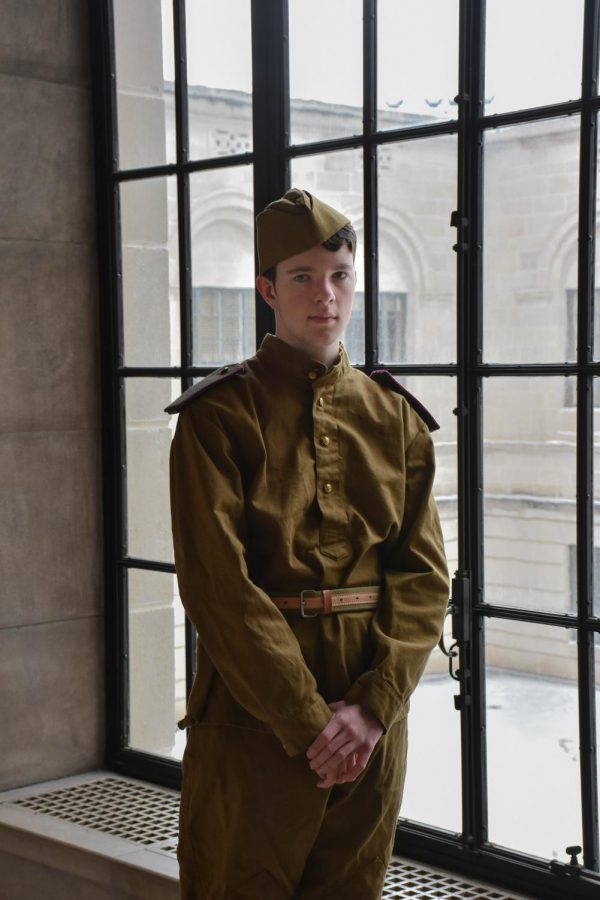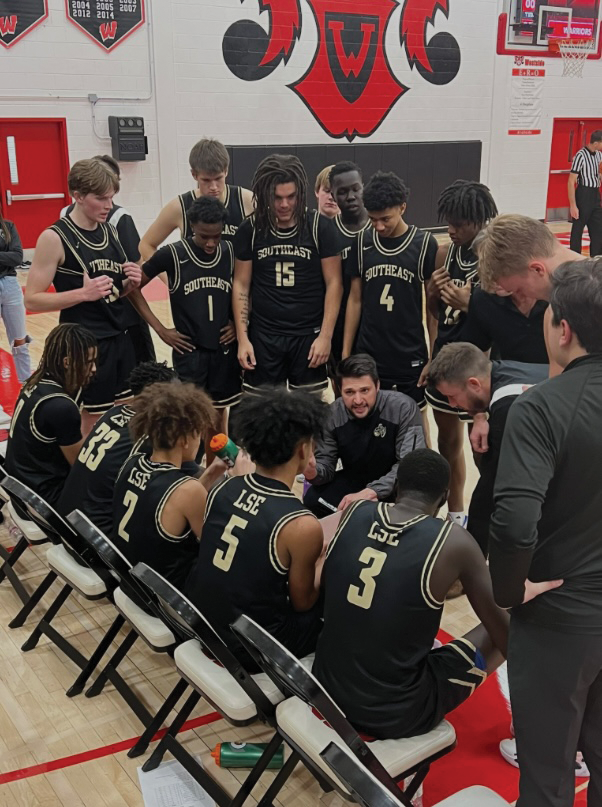History Brought To Life: How Cole Cressler preserves the past by recreating it
March 16, 2019
“Push! Push! Push!” they yell. Sergeants scream orders, tanks rumble and shake the ground, and machine guns blast. The first wave of men pushes through the trench, soldiers go down as they are hit, and the sounds of gunshots ring out over the fields of Rockford, Illinois. Medics run up and down the trench, checking for survivors and cleaning up whatever blood they find on the bodies of their wounded infantry. All of a sudden, one of the supposedly dead men sits up.
“Can you grab me a gatorade?” he asks the passing medic. “I’m practically dyin’ out here.”
Every September, over one thousand World War II battle reenactors gather in Rockford, Illinois to shine a light on the dramatic action of the famous 1940s battles that is often forgotten about by the average citizen. It is the largest battle reenactment held in the United States and LSE sophomore Cole Cressler always looks forward to donning his sharply pressed uniform and marching into the battle.
Cressler was introduced to reenactments through boy scouting, joining “The Third Guard” battle crew when he was 14. The Third Guard is named for a World War II unit based in modern day Volgograd, Russia (previously Stalingrad) that was known for its perseverance. According to Cressler, in this famous battle on Stalingrad, the Germans had taken over nearly two-thirds of the city. However, as winter set in, the Russians surrounded them and thousands of Germans were forced to surrender.
Also according to Cressler, there are two different types of battle reenactments – a “tactical” and an “actual” reenactment.
“A tactical is where a bunch of us reenactors get together, and we get to shoot each other for fun,” Cressler said. This organized chaos brings together modern day people and the dramatic action of the 1900s. There is a tactical hosted at an abandoned brick factory in Peru, Kansas that Cressler has recently taken part in.
“A bunch of us reenactors will go out there and they’ll organize the different battles that we’ll stage for ourselves. It’s open to the public,” Cressler said.
On the other hand, an actual reenactment is considered an event, and this is where beautiful Rockford, Illinois comes into play. Rockford is a historic little French town, the wooded fields standing there acting as a stage for the standard infantry. Deep in the trenches of these woods, all of the famous battles go down, soldiers from different countries setting themselves up in their respective camps.
“You have the Germans, the Axis Powers camps and then the Allied Powers camps. Then you have this area where people put their [military] vehicles,” Cressler said. “You can go see them, and talk to the owners, and there’s a market where you can buy military gear.” Some people take on positions of specific historical figures while others play a more generic role, one of a standard infantry soldier or medic.
Because it’s the cheapest option for a busy 15-year-old, Cressler plays a Russian when he does battle reenactments. One standard infantry Russian uniform can cost upwards of $300. However, standard United States gear can set someone back about $1,000. Going into battle as a Russian, Cressler typically wears a tunic, cavalry pants, knee-high boots and a belt with ammunition patches on it. If he’s lucky, he’s given a helmet.
Last September, Cressler played a medic in the reenactment at Rockford, due in part to the fact that he’s a minor, and therefore not allowed to carry a weapon at that reenactment. He prefers tacticals, because they allow him to carry a rifle.
“I like the tacticals better, because there’s a bit more freeness to it. I don’t have to play a certain role,” Cressler said.
It’s no surprise that Cressler got involved with battle reenactments because of the dramatic combat of it all. “It’s a bit of fun, getting to be apart of the action, playing something that you may never get to do,” Cressler said. “The reason that reenactments started back in the ‘50s was because people were really wondering what it felt like for people who went through World War II.”
For the spectators, it’s simply a learning experience. “[It’s] something that you might not want to personally take the time to study, but where you can just go and watch for an hour, instead of doing the years of research that I’ve done.”
Cressler has spent hours upon hours researching the differences in battle tactics between the Russians, Germans and Americans, whereas an audience member at one of these events can experience it all through a simple hour of interactive entertainment.
Because there are almost no formal practices in Lincoln, Cressler finds himself researching each battle to the best of his ability, and then blindly following the orders of his sergeant when the day of the event comes around.
“If the sergeant tells me to suicide charge the machine gun nest, and I’m not the one carrying the sniper, well, then I’m gonna go suicide charge that machine gun nest or risk being shot by the sergeant in charge.” According to Cole, soldiers would rather be shot by a commander or sergeant than taken prisoner of war (POW).
Cressler describes the set up of soldiers in waves. It’s a series of push and pulls, a strategic placing of men in the most effective formation possible.
“The first wave would run towards the trench in the middle of the field, but then get pushed back, so then we’d fire some artillery onto the trench and then the second wave would push and take the trench.”
In order to keep the action as realistic as possible, the soldiers wear ear plugs, shoot off “blanks” and men who are shot actually go down on the field, pretending to die as the medics tend to them. The sound of gun shots ringing out is deafening.
Because Cressler is interested in such a unique hobby, he finds that not many kids relate to it. As he says, that’s just the “nature of Lincoln.” According to Cressler, at Southeast, this hobby is so specific to him that the topic goes over most of his peers’ heads. However, Cressler loves the commonalities he has with those who do play battle reenactments on a regular basis. He’s gone to Illinois, Kansas, and Missouri for these events, although he plans to go to more states in the near future.
However, these commonalities may be few and far between, especially within the community of Civil War reenactors. There was an article written in the New York Times in July 2018 titled, “The Decline of the Civil War Reenactor,” which argues that Civil War reenactments have been and are actively dying out due to the expense of it all and the rise of video games. On the contrary, allthough Cressler is dedicated to the action of World War II, he says that this is not the case with Civil War reenactments.
“Yes, they could be dying out, in terms of on the small scale, but you still have massive scale ones going on,” Cressler said. “This year, the big trip that our crew did was to Gettysburg, because they were doing the 150th anniversary battle there, so there were thousands of reenactors.”
In fact, because Cressler’s battle reenactment crew is relatively small, they have the ability to do both World War II and Civil War reenactments. According to Cressler, Civil War uniforms are harder to come by these days, though, especially because they are so out dated. This may be a reason that the New York Times claims these events are dying out.
Battle reenactments are all-day events, exhausting for those involved. At the end of the day, all who had “died” in the battle come to life again, preparing to leave the action behind and return to the monotony of their daily lives. Slowly but surely, Cressler and his friends pack up their camps, take off their uniforms and change back into normal street clothes. As they drive away in Subarus and Toyotas, the sun sets on Illinois. The machine guns and rifles are put back in their cases, the tanks resting in closed garages. The lights illuminating the battle are field shut off, blanketing the scene in darkness, and everything materialistic that reminisces of the day is gone.
However, the battles still survive, and live on in the minds of audience, as well as the reenactors themselves. This is why they do what they do. History has already been made, but during these reenactments, it’s brought to life again.









